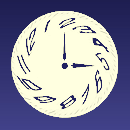

I attended the Narcolepsy Network (NN) national conference in October. My purpose in going was to gain insight into how they achieve their goals of promoting awareness, accommodation, research and support for people with narcolepsy, in order to apply this to the Circadian Sleep Disorders Network. In addition, I hoped to learn more about how their organization was structured.
I had realized that our goals were similar - theirs in regard to narcolepsy, and ours for circadian disorders - but I hadn't realized how similar our issues were. They have real trouble convincing people that narcolepsy is a real, neurological problem. Most doctors aren't familiar with it, and often misdiagnose it as primary insomnia, depression, ADHD, or chronic fatigue. Most employers are intolerant of the accommodations they may require - for example, naps during working hours. They suffer from daytime sleepiness, and many control it with medication. Some can't tolerate the medication, or it may not be effective; and even when it works, patients report residual tiredness. Some doctors still call it "insomnia" and tell you to just go to bed earlier. We CSD people have heard all this too.
Many narcolepsy patients are also night owls, and have trouble falling asleep until very late or getting up early. This leads me to wonder how many of them may be misdiagnosed: their circadian rhythm is shifted, and they are tired all the time, but they were diagnosed by a narcolepsy specialist, so he saw narcolepsy. An MSLT (Multiple Sleep Latency Test) is often used in diagnosing narcolepsy, but the same results are obtained with normal sleepers after several nights of only 4 hours sleep.
I suspect some of us DSPS types may also have a degree of narcolepsy, so that even when we sleep the hours our body demands, we are still tired in the daytime. Perhaps both groups of disorders are just different manifestations of the same underlying genetic/biochemical issues.
I put out about 50 CSD-N Brochures at the membership counter. These had been taken by the end of the conference. I also gave the brochures directly to people I talked with.
I attended a lot of talks and support meetings. Some things that were mentioned and are worth repeating:
When I introduced myself to Dr Rogers, she immediately said "Circadian disorders: that's the last frontier." Meaning that's the area of sleep medicine that many doctors still don't really know as much about, even to diagnose.
Any doctor can claim to be a sleep specialist. Look for sleep specialists who are board certified. Up till now, this just meant passing a special exam. Starting next year this will require specialized training. Sleep labs [in the U.S.] should also be accredited by the American Academy of Sleep Medicine. When you go to see the doctor, be prepared with three priority points you want to cover, and bring handouts to support your suspected diagnosis.
There is a lot of emphasis at NN on providing support to narcolepsy patients. Attending the national conference has been a turning point for some. NN encourages formation of local support groups. I attended a lecture on how to form such a group, and I've since attended the local Washington DC group (which welcomes anyone suffering from excessive daytime sleepiness). Support for spouses/partners is important, too - it's not easy for them - and they are welcome at most support groups as well as the NN conference. Also, people can call the NN office and get help - instant response, or referral to someone who can help.
Interesting talk by Julie Flygare on communicating about narcolepsy (CSD has similar issues). Keep a positive tone. Some useful phrases to use: "fascinating disorder"..."have you heard of it?"..."for me the strangest thing..."..."like being awake for 48 hrs"... "sleep is like hunger: if you haven't eaten in 48 hrs, you HAVE to eat"
Additional random items:
I did meet a lot of people, and introduced them to Circadian Sleep Disorders Network, and circadian sleep disorders generally. I had met Ann Austin at the NIH meeting in May, and she introduced me to some people at the conference who could help. Other people I met included Patricia Higgins, the outgoing president; Oleta Elliott, a former president; Ramon Werbeach, their web guy and board member (who has added a link to us on their web site); Eveline Honig, the executive director; Dr Eve Rogers, a sleep (narcolepsy) specialist; Julie Flygare, a lawyer in Virginia who is devoting her life to health advocacy; and many others. I want to thank the people I met for being uniformly welcoming to me and supportive of our endeavors with Circadian Sleep Disorders Network.